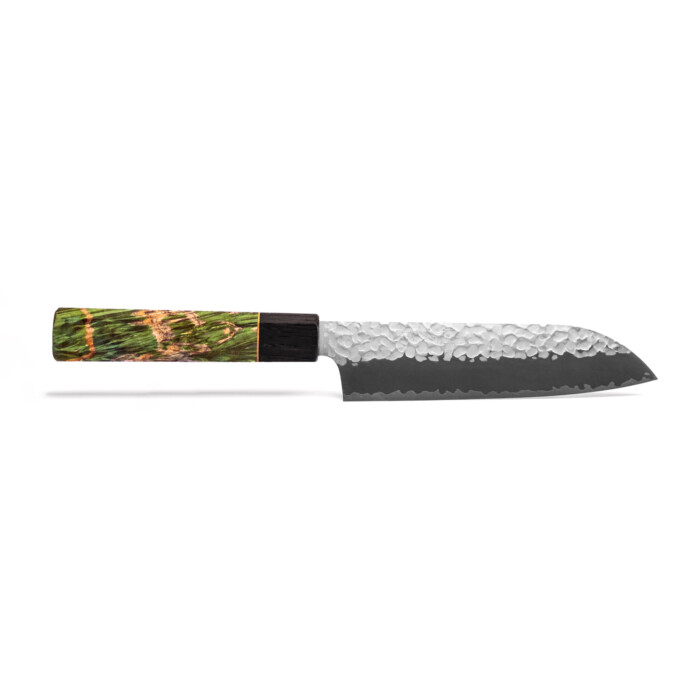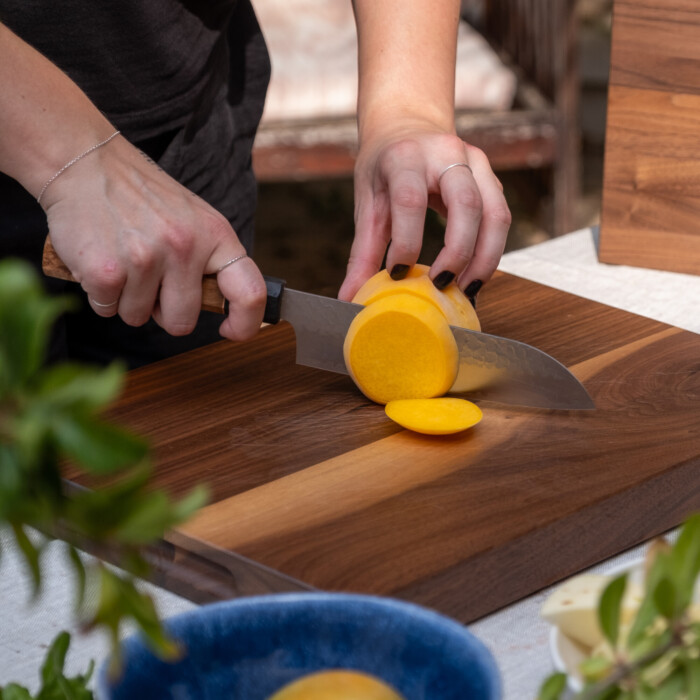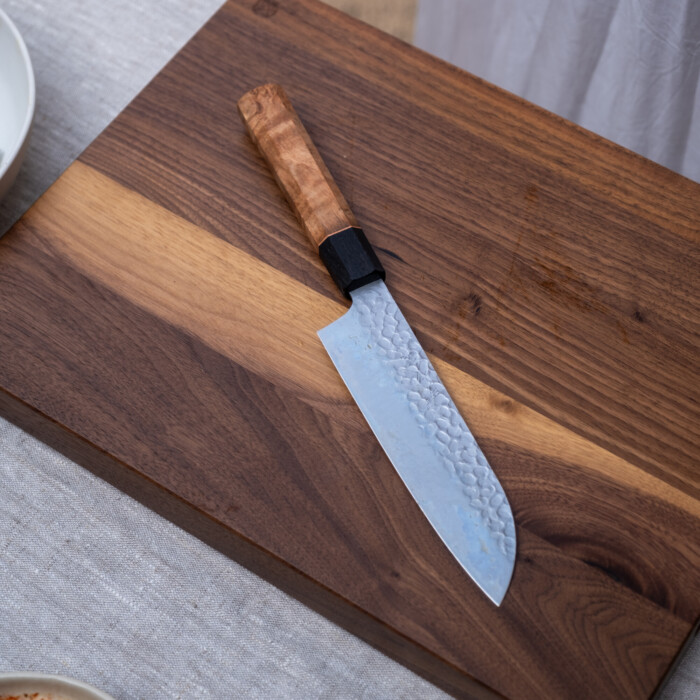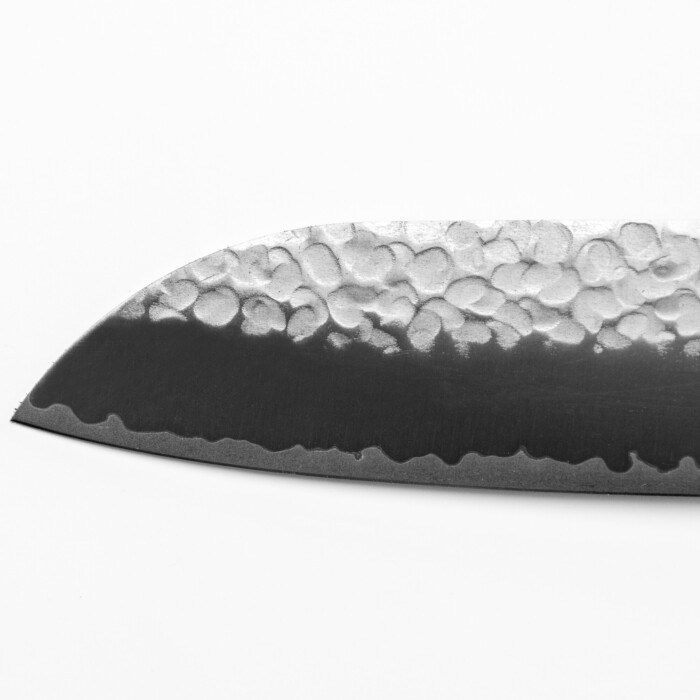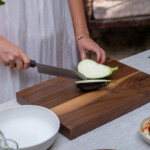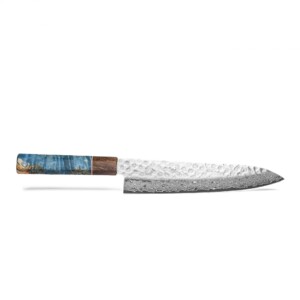The Santoku
The Seki Kyuba KATA Santoku, with its 16.5cm blade, is a testament to the versatility of Japanese kitchen knives. “Santoku” translates to “three virtues” in Japanese, referring to its excellence in slicing, dicing, and mincing. This 16.5cm length offers a perfect balance between the agility of a smaller knife and the capability of a full-sized chef’s knife.
Crafted with a VG10 steel core and a 3-layer construction, the Seki Kyuba KATA Santoku embodies the pinnacle of Japanese metallurgy. The VG10 core provides exceptional edge retention and ease of sharpening, whilst the outer layers contribute to overall durability and stain resistance. The blade’s hammered finish adds a touch of artisanal beauty and helps to reduce food adhesion during cutting, making your prep work smoother and more efficient.
The gently curved belly of the Santoku allows for a slight rocking motion, making it ideal for those transitioning from Western-style knives to Japanese craftsmanship. Its shorter length compared to a traditional Gyuto makes it particularly suitable for cooks with smaller hands or those who prefer a more nimble blade.
If you prefer a knife with a more specialised tip for precision work, consider the Bunka instead. However, if you’re looking for an all-purpose knife that excels at a wide range of kitchen tasks, the Santoku is an excellent choice.


The Blade
The blade in the KATA line is designed to make cooking more enjoyable as cutting through produce will become an effortless task. The blade is handcrafted by skilled Japanese blacksmiths in Seki, Gifu village in Japan with high-quality VG10 high carbon stainless steel core, with a 3-layer construction. VG10 is a premium steel known for its excellent edge retention and corrosion resistance.
The sharp blade is set in a premium-cut, waterproof stabilised maple burl wood available in Mediterranean Blue, Olive Green, or Natural Brown. The knife comes in a handcrafted, minimalist wooden box wrapped in a unique illustration strip.
VG10 steel offers an excellent balance between sharpness, durability, and ease of maintenance. The blade has a Rockwell Hardness rating (HRC) of 60-62, which ensures the edge remains sharp through regular use. This means you can enjoy consistent cutting performance with minimal upkeep. The blade allows for precise, effortless cuts, enhancing your overall cooking experience.
The Handle
The beautiful handles are made with extremely limited European maple burl dyed in an Natural Brown colour and feature a subtle copper ring under the oak bog wood kakumaki (collar of the handle). The wood has to be dried for two years before it undergoes the process of stabilisation. This ensures the wood is completely waterproof to avoid bacteria growth and is able to last generations.
The blade’s kakumaki (collar) is made with oak bog wood. A wood ranging from 2,500 to 5,000 years in age. Its age and living conditions give it a unique character and rich natural colour variation determined by its age. Giving you a knife with a rich history.
The stabilised premium-cut maple burl is shaped into an octagonal shaped ambidextrous handle to give you a firm grip on the knife. Not only are the handles aesthetically pleasing, they are also perfectly balanced, light and comfortable. This allows for maximum precision and more controlled movements during use.
No two handle colours or patterns are ever the same as the natural properties of each wood block are unique and will absorb the colour dye differently. This will give each knife a beautiful unique look and it can serve as an unforgettable gift.


Because Presentation Matters Just As Much


All our Seki Kyuba KATA kitchen knives arrive in a handcrafted, minimalist European oak wooden box with a delicate waxed finish. The box is wrapped in our signature Oishya illustration strip featuring the Onna Bugeisha – legendary Japanese female warriors.
Inside, you’ll discover a beautifully designed certificate with two sides, each telling an important part of your knife’s story.
On one side, you’ll find a genuine 5 yen Japanese coin attached with an elegant note. There’s an ancient superstition that giving someone a knife is bad luck because it “cuts” the relationship between giver and recipient. The way around this? Attach a coin of symbolic value to the knife, which the recipient returns as payment.
We chose the 5 yen coin specifically because in Japanese, go en (五円) is a homophone with go-en (御縁), meaning “relationship,” “connection,” and “bond.” By exchanging this coin with the receiver, you’re not just avoiding bad luck – you’re actively strengthening your connection.
The reverse features your knife’s Certificate of Authenticity, documenting genuine Oishya craftsmanship from Japan’s legendary blade-making regions. Each certificate is hand-stamped with our traditional Japanese hanko seal – a mark of authenticity used in Japan for centuries.
The Blacksmith
The spirit of Samurai “Bushido” has never faded away from the history of Japan. The art of greatest sword smiths has been inherited through 780 years till now and it’s present in Japan’s Samurai Knife City, Seki in Gifu Prefecture, where Seki Kyuba knives are made.
High quality katana and kitchen blades are made with Japan’s traditional swordsmith technique and the latest technology, and are famed throughout the world today, especially high end kitchen knives.
Our partnership with one of the most talented and prominent blacksmiths of Japan resulted in Seki Kyuba kitchen knives, that are perfect for those that demand the highest quality. Being part of the Japanese knife community and owning a knife like this is a great honour and pleasure. We welcome you to Kyuba knives world.

